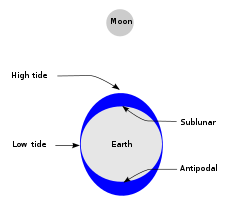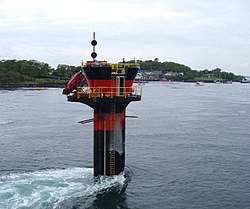Tidal energy
Tidal energy, sometimes called tidal power, is using the energy of moving water in tides and open ocean currents. It is most used for hydroelectricity.
Tidal energy systems can take kinetic energy (energy caused by movement) from the moving water of rivers, tides and open ocean currents. They can also use potential energy from the difference in height between high and low tides. Getting energy from tidal currents is becoming more popular because people believe that it does not harm the environment as much as barrages or dams. Many coastal sites around the world are being checked to see if they can be used to produce tidal energy.
Like other hydroelectricity (electricity made using water), tidal power makes no pollution and is a renewable energy source. It is renewable because tides are caused by events that happen in the solar system and so will not run out. Tidal power has great potential for future power and electricity generation because of the very large amount of energy contained in these systems. Tidal power is reliably predictable (unlike wind power and solar power). In Europe, tide mills have been used for nearly 1,000 years, mainly for grinding grains. Modern tide mills provide tidal stream power.
Many things affect tides. The pull of the Moon is the largest effect, and most of the energy comes from the slowing of the Earth's spin.
Tidal Energy Media
Sihwa Lake Tidal Power Station, located in Gyeonggi Province, South Korea, is the world's largest tidal power installation, with a total power output capacity of 254 MW.
The Rance Tidal Power Station, in Brittany, northwestern France, was the first large-scale tidal power station (1966), with a total power output capacity of 240 MW
The world's first commercial-scale and grid-connected tidal stream generator – SeaGen – in Strangford Lough. The strong wake shows the power in the tidal current.
Sources
- Baker, A. C. 1991, Tidal power, Peter Peregrinus Ltd., London.
- Baker, G. C., Wilson E. M., Miller, H., Gibson, R. A. & Ball, M., 1980. 'The Annapolis tidal power pilot project', in Waterpower `79 Proceedings, ed. Anon, U.S. Government Printing Office, Washington, pp 550-559.
- Hammons, T. J. 1993, 'Tidal power', Proceedings of the IEEE, [Online], v81, n3, pp 419-433. Available from: IEEE/IEEE Xplore. [26 July 2004].
- Lecomber, R. 1979, 'The evaluation of tidal power projects', in Tidal Power and Estuary Management, eds. Severn, R. T., Dineley, D. L. & Hawker, L. E., Henry Ling Ltd., Dorchester, pp 31-39.
| Wikimedia Commons has media related to Lua error in Module:Commons_link at line 62: attempt to index field 'wikibase' (a nil value).. |







